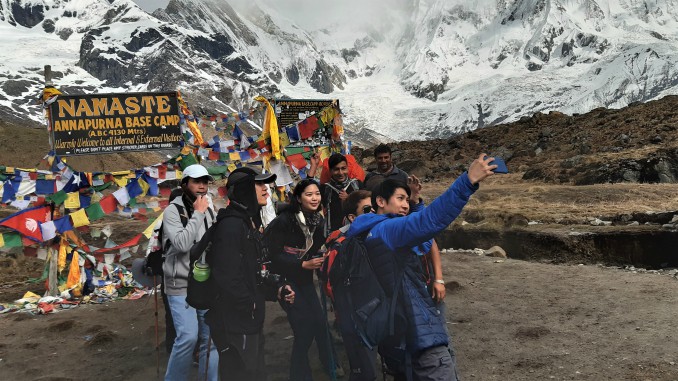
By Rup Narayan Dhakal : Annapurna Base Camp (Kaski)—The Annapurna Base Camp (ABC) trek which is popularly known as Annapurna Sanctuary trek is one of the most popular trekking routes in the world famous Annapurna Region.
The breath taking 360° views of snow-capped mountains is the key attraction of the ABC which is the last destination of the sanctuary trek. The 7 to 12 days trek reaches up to 4,130 meter where the trekkers are welcomed by dozens of beautiful mountains. Green forests, water falls, hot water springs, rivers and settlements of various ethnical groups are also the attractions of this route. Hiking routes made of stone steps could be new experiences for many.
The accommodation is not a big deal as there are numbers of tea houses and lodges along the route. Cell phone signals are available in lower parts of the route and internet and GPRS facility is available in most of the times if the weather doesn’t go bad. Nepali style food- Dalbhat, Indian and continental cuisines are available on those tea houses. But the price is higher than in Pokhara and Kathmandu. The menu seems expensive as you ascend. Hot water shower and facility of electricity are also available in most of the areas. The mineral water bottles are banned from Jhinu to ABC and treated filter water is available along the way.
Room rate seems reasonable as most of the hotels charge below $10. The boring part is potato curry that is included in every shift’s meal. Mustard leaves are seasonally available. As there is no road facility above than Ghandurk, entrepreneurs are compelled to rely on porters and mules or donkey. In upper parts of the route, even donkeys are also banned due to likely narrow route. Sometime avalanches, leeches, hypothermia and acute mountain sickness could turn problematic, so trek safe and adopt the concept of safety first. And don’t forget to keep to the local rules.
October, November and December are best months to trek as mountains seem crystal clear with spectacular views during that time. However thousands of trekkers could be seen even in March, April and May in ABC trek. According to Annapurna Conservation Area Project (ACAP) which is governed by National Trust for Nature Conservation, some 80,000 trekkers enjoy that route every year.
There are two major routes to start the sanctuary trek. The first goes through Nayapul-Birethanti-Syauli Bazar-Ghandruk-Komrong Danda-Kimrong Khola-Ghandruk-Chomrong-Sinuwa-Bamboo-Dovan-Himalaya-Deurali-Machhapuchhre Base Camp-Annapurna Base Camp. And second starts from Phedi and then Dhampus-Pothana-Tolka-Landruk-New Bridge-Jhinu-Chhomrong- Sinuwa-Bamboo-Dovan-Himalaya-Deurali-Machhapuchhre Base Camp-Annapurna Base Camp. Kande is the third point that also shows the way to Pothana to connect the second route.
Hiunchuli(6,441m), Annapurna South(7,219m), Barah Shikhar (7,647m), Annapurna I (8,091m), Khangsarkhang, Singhchuli (6,390m), Tent Peak (5,127m), Annapurna III (7,556m), Gandhava Chuli (6,249m) and Fishtail (6,993m) could be observed from ABC. Glacier dome aka Tarkekang (7,193) and Gangapurna (7,455) could be seen only from MBC.
Nepali national should pay NPR 100, while SAARC national NPR 1000 and non SAARC nationals 3,000 inclusive all taxes to ACAP or to an agency to enter the Annapurna Region. Besides that trekking-permit fees, a trekker should also bear Trekkers’ Information Management System (TIMS) fees.
TIMS card is applicable in all trekking areas of the country including restricted areas. Group trekkers will have to pay Blue TIMS cards by paying a fee of Rs 1,000 per person, while FITs have to get Green TIMS cards by paying a fee of Rs 2,000. Similarly, group trekkers from SAARC countries have to pay Rs 300 for TIMS cards, while FITs from the SAARC region have to pay Rs 600 each.
Aannapurna region is an example of nature conservation, biodiversity, cultural heritage protection, ecosystem and sustainable development. Launch in 1986, the project area extends in 7,629 sqkm and is the home to over 100000 residents.

Leave a Reply